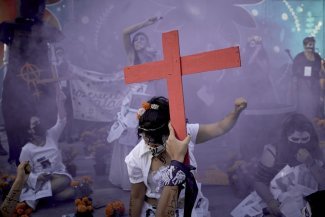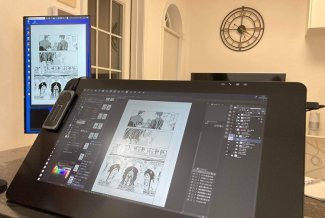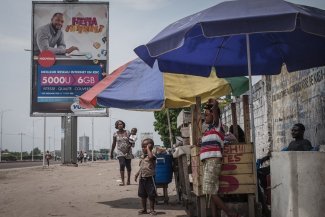“Women, walk with others like you/They are your sun.”
These verses by Jenyffer Nascimento, author of the book of poems Terra fértil (Fertile Land), sum up the spirit of Fala Guerreira (Speak Out, Woman Warrior), a magazine written by and for women on the periphery, or outskirts, of São Paulo, seeking to encourage locals to reflect, to value their struggles and to discuss issues such as male violence against women, female sexuality and motherhood.
Fala Guerreira emerged as an initiative of a group of women from Jardim Ibirapuera, a neighbourhood on the outskirts of São Paulo. The collective’s history dates back to 2011, when they witnessed the harassment of a woman at a poetry sarau.
Their repulsion of this violence and their collective anger gave rise to the Mostra das Rosas, a feminist cultural exhibition by women from the area. A magazine, born in 2015, was another step in the same direction.
This is how they describe it: “We gave birth, and the gestation period, often contradictory and painful but, above all, brave and empowering, is reflected in the pages of the magazine.”
But what are the saraus? They are the epicentre of a literary and cultural movement that has transformed the outskirts of São Paulo.
Saraus are meetings, almost always in humble bars – botecos – in which the regulars spontaneously take the floor to read a poem, written by themselves or other authors.
Whilst in some parts of the world poetry is confined to small elitist circles, on São Paulo’s periphery it is expanding its reach and becoming the most popular art form. The growth of the saraus, like poetry slams elsewhere, has seen no end since they first emerged, almost two decades ago, in the poor neighbourhoods of South America’s biggest city.
Art in the quebradas
Binho, a poet, likes to say, “One swallow does not make a summer, but it can wake up the entire flock.” He knows it from experience - for fifteen years he promoted a sarau in his bar that transformed the Campo Limpo neighbourhood.
Three years ago, he had to close the bar, but the sarau lives on in its itinerant version. It is, alongside Sérgio Vaz’s Cooperifa, the oldest of the 80 or so saraus that have risen up all over the city, from the periphery to the centre.
In the favelas and outlying neighbourhoods of São Paulo, the streets are badly paved. Broken. This is the root of the popular name for the outlying neighbourhoods: quebradas (literally, ’broken’).
Eleven per cent of the population (over 2.1 million people) in South America’s wealthiest and biggest city live in favelas and informal neighbourhoods, whilst the market for luxury goods grows despite the crisis.
And this offensive inequality is growing. In Brazil’s economic capital São Paulo, the Gini index that measures inequality rose from 0.57 in 1991 to 0.64 in 2010.
This inequality reinforces a tacit apartheid, with the affluent, central neighbourhoods becoming increasingly cut off from the outskirts, separated by the Tietê and Pinheiros rivers, and an invisible wall that no bridge is capable of crossing.
But what if the most effective bridge were poetry? The saraus are, first and foremost, meeting places and centres of activism.
“The only public space the state has given us is the bar. And the bars suddenly started filling up with women, children and poets,’’ says Vaz, the founder, of Cooperifa - the most popular sarau in the city, which celebrated its 15th anniversary in September.
’’They thought we would end up drinking cachaça but we converted the bars into cultural centres; and now they have no way of controlling us, because the one thing we are not short of on the periphery are bars,” he says.
Vaz is the author of the aphorisms that can be seen on posters or as graffiti decorating the streets of São Paulo’s southern neighbourhoods . “Revolutionary are those who want to change the world and have the courage to start with themselves.” “Yesterday I dreamed your dream/Without knowing it was also mine.”
The dream led them to Argentina in 2013, when the Binho and Cooperifa saraus were invited by the Buenos Aires Book Fair to tell their neighbours about their work.
In Brazil, social class has a colour: on this side of the bridge, the city darkens and becomes mixed race and black. “The world is different on this side of the bridge,” said the Racionais MC’s, a rap band from the south of the city.
When these rappers emerged in the 1990s, the murder rates in neighbourhoods such as Campo Limpo, Capão Redondo and Jardim São Luis were outrageous. They were linked not only to drug trafficking and crime but also to the violence of the police, who were accused of being profoundly racist.
According to a study by the University of São Carlos, in São Paulo - a city with a 30 per cent black population - 61 per cent of people killed by police are black. Among young people aged between 15 and 19, two-thirds killed by military police are black.
The dream is about reclaiming identity and overcoming stigma. The poems recited in the saraus speak of racism and discrimination, but they also “depict routines, movements and landscapes that bear witness to a culture of the peripheral being, no longer based on the idea of privation but, rather, on the idea of cultural wealth,” writes Lucía Tennina, a researcher and lecturer at the University of Buenos Aires.
Therein lies the victory of the saraus: “The ruling classes build ideas in the collective imagination that inferiorise the subjugated and preserve their dominion. Television portrays the periphery as something ugly, but it is not; in the same way as the Africans or the indigenous peoples were not primitive,” maintains Binho.
The voice of women warriors
This art created by and for ’the peripheries’ has not, however, always been open to half of the people in these communities: the women. But women began to realise the need to take gender issues to the saraus. They began to question macho attitudes, the micro and not so micro machismo that affects society as a whole, and that is reflected in the saraus.
A group of women launched a campaign, #NãoPoetizeSeuMachismo (Don’t poetise your machismo), to denounce the male domination of the saraus.
“To poetise machismo is to disguise acts of machismo such as harassment or violence through poetry and conversation that attempt to minimise the wrongdoing,” explains Camila Costa, one of the organisers of the campaign and the Sarau Antene-se.
“We believe that all women are feminists, although they may not yet realise it,” points out Silvana Martins, designer of Fala Guerreira and founder of the Sarau de Ademar, one of the first saraus with a large female presence.
Today, they are gaining ever greater ground in the drive to make the voice of black and other socially-excluded women heard, a voice that is often smothered as much by white, middle-class feminism as by their male peers. They have even dared to take on key figures in the movement, from the Racionais MC’s to the author Férrez.
The change brought about by the saraus is not abstract: it is there, in the dozens of people who “didn’t know what a poem was and who are now publishing books,” as the musician and writer Zinho Trindade points out.
It is there, also, in the young people from Capão Redondo, who used to hide their origins and are now claiming their peripheral identity with pride. Fifteen years after the first saraus came into being, they are transforming life in the neighbourhoods.
And now, the women are taking the floor.










